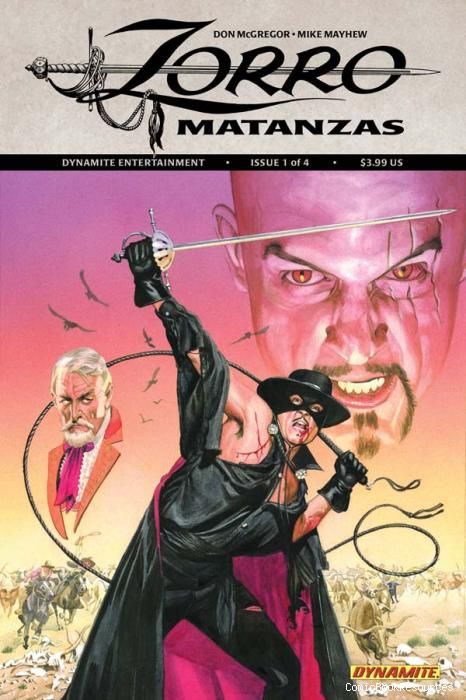"Zorro: Matanzas" is a comic that's been in the works for over a decade, originally intended for publication by Topps when they had the license to the character, but never released for various behind-the-scenes reasons. This week, the first issue of this mini-series finally hits shops courtesy of Dynamite, the current license holder, and it stands out as a different book than their regular "Zorro" series, but should still appeal to fans of the character and act as an introduction for those new to it.
This first issue is mostly an introduction to Zorro, his Don Diego alter ego, and the life he leads when not dressed up, fighting crime. The opening pages are a meticulous showing of the transformation that happens when he takes off his cloak, mask, and hat to reenter the civilian world where he plays the part of an effeminate son who spends all of his time reading, drawing, and being a general disappointment to his father. The distance between Don and Zorro is great and it's interesting to see how much is an act and how much is the reality. Reading the pages where he washes himself and puts on Don's clothing, you get the impression that his entire life is fake when he's not Zorro, but, later in the issue, we see that it's not so simple. McGregor presents Zorro/Don as a complex character with conflicting motivations and characters traits, which only makes him more intriguing.
There isn't a lot to this issue beyond presenting the difference between Zorro and Don, and showing the rift between Don and his father. A confrontation with an old foe is hinted at, but that's left for future issues. The pacing in this issue is slow and somewhat overwritten with the narration, which gives us every insight and thought of the characters. Some insight is needed, but McGregor goes overboard, making the issue something of a chore to read. He doesn't rely on Mike Mayhew to communicate any of the characters' thoughts except in the case of the mute Bernardo.
Mayhew's art, being from over a decade ago, is much different from the recent work that readers may be expecting. He uses a much more traditional, classical style in "Matanzas" with clean, fluid line work and dynamic posing of characters. His page layouts use square and rectangular panels almost exclusively, but he still crafts intriguing and well-thought-out pages, mirroring panels, and creating effects that only work when the whole layout is looked at as a whole. It's a shame that there is so much narration as characters wear their feelings on their faces. While the style is somewhat antiquated, it's very good, solid art.
While "Matanzas" doesn't exactly fit together with the ongoing "Zorro" comic stylistically, it makes a good introduction to the characters. The writing just needs a lighter touch and to get to the plot a little quicker.

